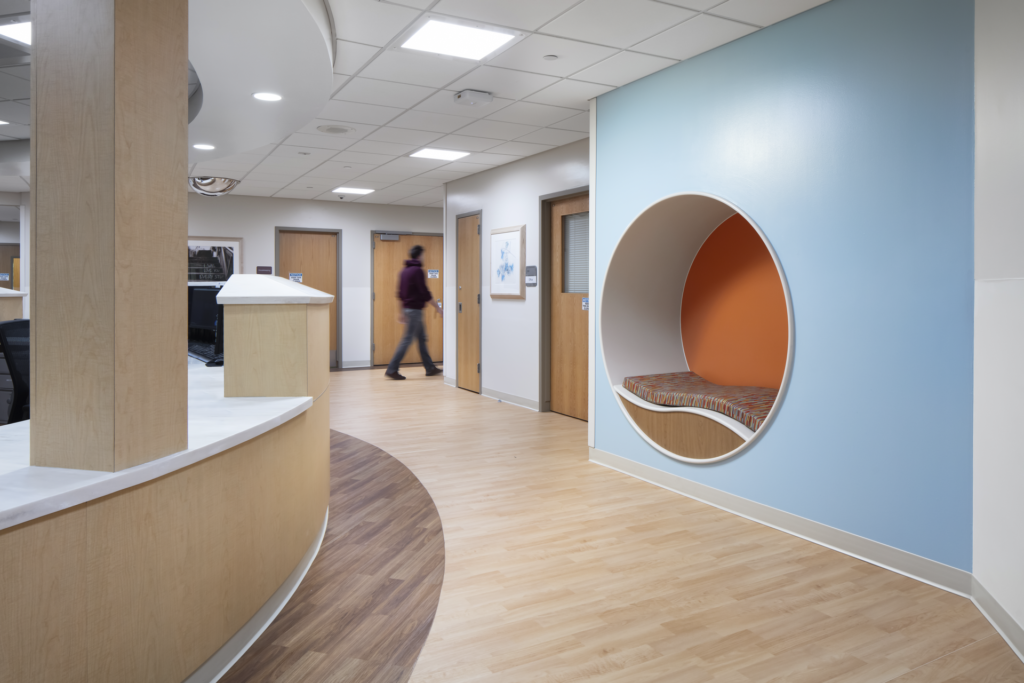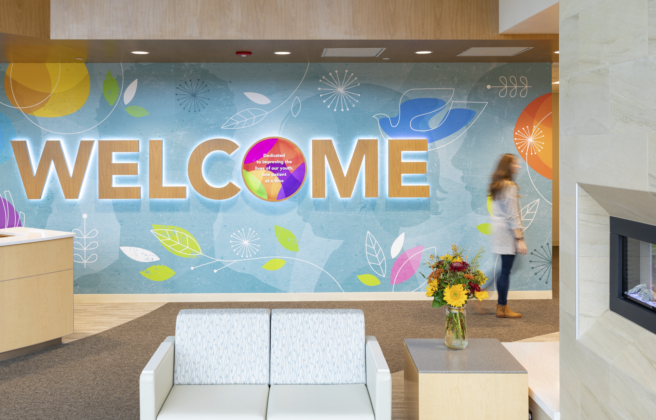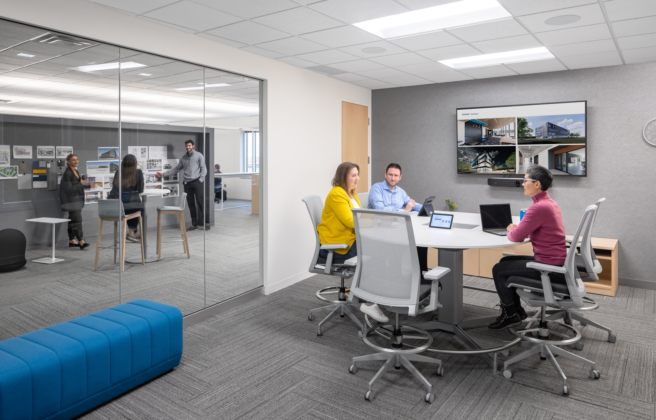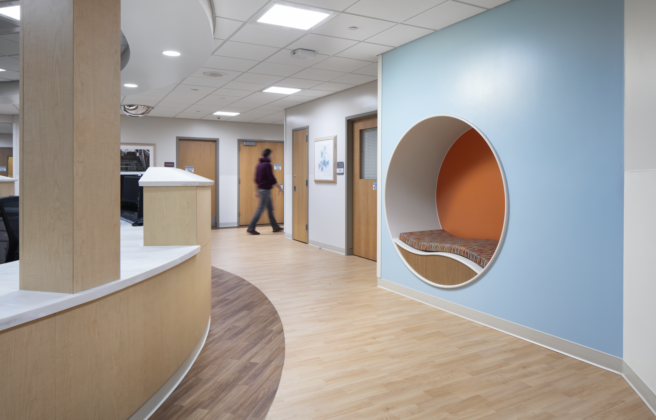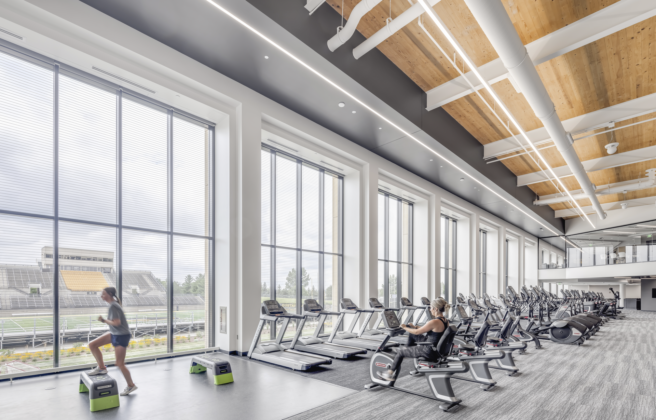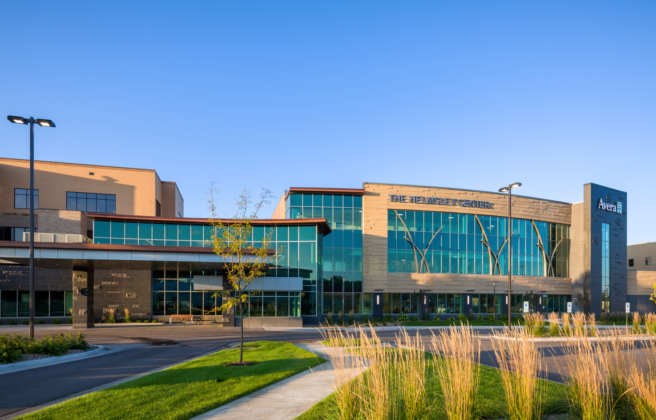When a person finds themselves in need of mental or behavioral health care for themselves or a loved one, navigating the web of services and providers available can be a confusing process. There are incredibly varied levels of treatment throughout the continuum of care that provide differing degrees of support to meet the unique needs of an individual. A person’s path through the mental health system isn’t linear—people often move between or in and out of programs, which is exactly why each of the many care options available are tailored to meet people where they are. Of course, that means architecture, interior design, and programming needs vary between facility types.
Caring for All Needs
Treatment options range in intensity, with outpatient care like one-on-one counseling, support groups, and school-based services at the bottom of the continuum. Intensity increases toward the top of the graph with secure and forensic facilities. The path, which curves across the graphic, illustrates the individualized nature of mental health treatment plans—a person may need only one of these programs, such as a regular engagement with a counselor, go through a series of them, such as moving to higher or lower levels of care, or go back and forth.
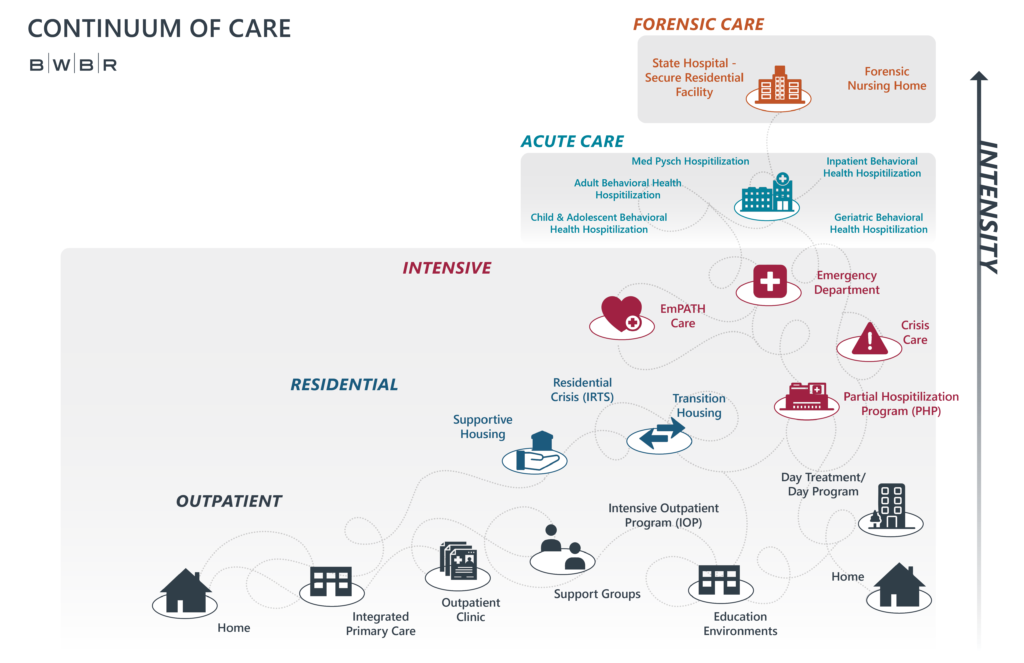
BWBR has designed facilities across the spectrum, and although design approach may shift from space to space, some guiding principles remain the same—our commitment to creating facilities that are innovative, human-centered, and safe for patients, families, and staff.
Let’s see what the continuum looks like in practice.
Outpatient Clinics: Outpatient facilities widely vary depending on clinical programs that are offered. Counseling services often take place in these clinics, whether it’s a drop-in group allowing people to come to as many or as few sessions as desired, or programs with a set duration, curriculum, and cohort. Oftentimes outpatient programs will specialize in a particular focus, such as grief support, addictions, or eating disorders. Teaching kitchens for patients with eating disorders or pediatric consult rooms with observation space for parents to learn therapeutic techniques are just a few examples of offerings that may be seen in a facility. No matter the space type, design should serve to enhance the programming that providers employ. Since these settings are the least intensive, there are no code requirements for ligature resistance and security, allowing for greater versatility in furniture and hardware selection. Many clinics share facilities with other levels of care, in which case requirements for egress and locking may exist. Avera Behavioral Health Center is one example of this, a 110-bed facility with a range of both inpatient, outpatient, and day programs. For outpatients that come and go from a facility, it’s especially important to create a welcoming exterior—Avera features an open glass entryway and a sculpture that celebrates recovery, hope, and health. Inside, lobby and waiting areas should prioritize privacy with acoustic treatments, and a range of seating, as well as simple wayfinding for patients independently navigating the facility.
Similarly, Partial Hospitalization Programs (PHPs) provide more intensive, frequent treatment for outpatient cohorts, offering a structured schedule of individual and group therapy sessions throughout the day. Pine Rest’s new Pediatric Center for Behavioral Health will house a PHP, along with other inpatient and outpatient programs. Because different programs exist within the same facility, privacy was key to creating a successful design. Strategic patient circulation and carefully planned shared and multifunctional spaces, like a separate pocket park for PHP, maintain separation between different levels of care. Spaces like a testing lab and eating disorder teaching kitchen support outpatient program goals.
Educational Environments: Design strategies for controlled sightlines, natural light, and acoustic treatments are critical in educational settings for children and adolescents who are sensitive to sensory disruptions. At Pankalo Education Center, which serves K-8 students with special needs, principles of “creative, calming, and compassionate” guided the team to create a facility that provides artistic empowerment in a supportive, safe learning environment. The key to the success of this educational/behavioral combination design was to provide layers of interventional spaces for students learning coping skills for self-regulation. Classrooms, community rooms, and hallways all integrate soundproofing, daylight, and seating options where students can calm themselves without interrupting surrounding classrooms and students.
Residential Treatment: Though they offer 24/7 care, residential programs are often longer-term than inpatient care, allowing for more home-like features and fewer restrictive measures to prepare residents to transition back to their everyday lives. Afton Place Intensive Residential Treatment Services (IRTS) is one program that utilizes abundant windows, nature-inspired design elements, and specialized treatment areas to support patients requiring care for mental health and co-occurring diseases such as diabetes, cardiovascular disease, and drug and alcohol addiction for up to 90 days. A sensory room is designed for patients to practice behavioral exercises and utilize cognitive relaxation tools such as wall murals and dimmable lighting.
Inpatient Care: For patients requiring intensive care, inpatient facilities can hold a negative stigma of being cold, scary, or confrontational. Ligature resistant measures, secure unit entries, and safe areas for staff are critical, but are only the minimum standard for design. BWBR’s Human-Centered Safety approach goes beyond this minimum, creating comforting, therapeutic environments that offer patients choice and control of their environment and improve healing and safety. Warm colors, abundant artwork, plenty of natural daylight, and an open nursing station are just a few elements at Regions Inpatient Mental Health Center that help patients feel welcomed and calmed. A central dayroom with comfy seating and private patient rooms with built-in desks, shelves for belongings, and private bathrooms help the unit feel home-like rather than sterile. UnityPoint Health – Meriter’s Child & Adolescent Psychiatry program is another example of a welcoming environment that prioritizes safety without feeling institutional. In pediatric facilities, pops of color and texture as well as engaging graphics and shapes result in a facility where children, adolescents, and their families feel comforted and empowered.
Forensic Facilities: Safety and security for both staff and patients stand out as top priorities in forensic facilities, serving people who struggle with severe mental illness, are considered dangerous, and are involved in the criminal legal system. Visibility is one component of safety, providing patients with reassurance that staff can see them and giving staff confidence that they have full visual coverage of a unit. Durability also comes into play, avoiding materials that could break and become hazardous or quickly wear down and require replacement. Yet, aesthetics remain a key element to preserve dignity and create an environment conducive to recovery. The Minnesota Security Hospital is one project where the original campus from the 1980’s presented challenging layouts and outdated facilities that made it difficult to provide safe, high-quality care. The BWBR team created a strategic plan using focused additions, standalone buildings, and renovations to yield the highest impact on safety and design while meeting budget. This allowed for a variety of unit sizes and types tailored to the care model developed by the treatment team, where patients progress through different units as they work toward transitioning out of custody. Each level of care features a new color palette, allowing patients to see their progression toward healing reflected in their environment.
From inpatient hospitals to outpatient clinics, each facility requires a distinct design approach to effectively support patient recovery. With a deep understanding of the varied needs across the continuum of care, the BWBR team is driven by thoughtful, human-centered design to create spaces that promote healing and well-being across the spectrum of behavioral health care.


